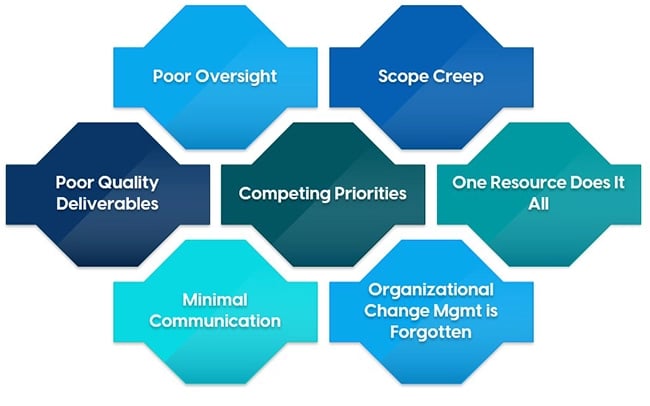Leadership at drug and devices companies are continually overwhelmed with the constant balance of driving daily work, managing resources, and addressing unplanned emergencies. This balance is then tested when leadership is tasked with implementing a number of yearly special projects. These projects often address process, strategic, technical, or regulatory requirements that must be addressed within a specific timeframe.
While important, these projects are often add-ons to an already overly burdened leadership resource. Further, it is likely that this individual did not gain a foundational education in Project Management, resulting in several unforced project implementation errors such as increased costs, delayed delivery times, and resource burn-out. As such, we often observe that these leaders struggle to successfully complete these complex projects on time.
In our experience, the top seven common areas that hinder project success are:

Poor Oversight
There is minimal awareness of ongoing project status, key activities, planned deliverables, issues, or risks. As such, project execution extends past planned milestones, issues or risks are never escalated, and key integration points are missed.
What You Can Do: In these scenarios, we have learned that proactive ongoing project governance and oversight is critical to successfully driving a team towards a successful implementation, while preemptively addressing anything that could negatively impact progress.
Scope Creep
As projects progress, aligned new opportunities are identified. Each opportunity is included into the scope of the project with minimal regard for impact to timing, level of effort, resources, and/or cost. The result is a larger than originally planned project with potential delays, more outputs, and downstream impacts to aligned project activities.
What You Can Do: We recommend assessing each recommended scope addition and making a thoughtful decision on impacts and execution timing. The goal is not to say "no" to everything, but say "yes" to the scope additions that matter.
Poor Quality Deliverables
Poor quality deliverables are often the result of not including the appropriate people to develop, review or approve content, not clearly defining the deliverables, or not providing enough time to develop/review content. In these cases, re-work is likely required, resulting in project delays.
What You Can Do: We have averted these situations by clearly defining the Definition of Done at the onset of the project along with the individuals responsible for deliverable creation and review. Ensure successful delivery of high quality content by defining realistic timelines.
Competing Priorities
If a resource is selected for a project, they may also have to balance daily work plus any other projects they are supporting, planned or otherwise. Projects can fail due to the resource delaying or deprioritizing project support for other competing activities or completely stopping the support of a project, altogether.
What You Can Do: The level of resource commitment must be defined and approved by their leadership at the start of the project. Oversight of the resource's project progress and awareness of potential availability conflicts should proactively identify resource support issues for resolution.
One Resource Does It All
It is an unfortunate but common occurrence for one person, who is not the project manager, to quickly accumulate several critical path project tasks. This person typically works in a silo, rarely provides timely updates to the project manager on task progress, potentially has lower quality of execution due to several competing priorities, and has delayed completion of project tasks. Project progression and dependencies all unfairly depend on this singular individual. Any or all of this resource's actions and behaviors can put a project at serious risk of failure.
What You Can Do: Immediately escalate the actions and/or behaviors to project sponsorship and determine whether the resource's non-project activities need to be temporarily transitioned from them to complete project activities or transition some of the project tasks to other equally capable resources. It is critical to understand how the project devolved to one resource managing more than what they capable of effectively completing to prevent recurrence. The team will also need to develop an approach to bring the project back on track, including updating project management deliverables to reflect the approach. Project sponsorship must be engaged to reinforce the decisions to prevent recurrence of behaviors.
Minimal Communication
A project exists, progress has been made, but very few stakeholders are aware of this project and few impacted stakeholders have been engaged in deliverable development.
This can result in duplicative project efforts from other functions, key stakeholders caught off guard, and/or projects that generate minimal interest/impact to the organization.
What You Can Do: Our approach is to have a detailed, cross-functional communication strategy in which project leadership has exhaustively identified all impacted stakeholders and are proactively keeping them engaged with the project – goals/outputs, status, and impacts.
Organizational Change Management is Forgotten
The project has been "completed" but adoption of the project outputs is sub-optimal. Post-project completion, there is no one with accountability of the project outputs (e.g., process owner), there is no objective measurement and monitoring of the project outputs, or the impacted stakeholders have rejected the project outputs and have reverted to their pre-project processes/activities/deliverables. Any or all of the potential outcomes could cause a project to ultimately fail, post-completion.
What You Can Do: These types of scenarios occur due to the lack of integrated Organizational Change Management (OCM) in the project. OCM should be included at the beginning and throughout execution of a project. By defining and assigning a business process owner, you have someone accountable for the sustainability of the project, post-completion. Defining and monitoring metrics will allow you to assess effectiveness of project outputs and utilize continuous improvement techniques for enhancement. Ongoing engagement of the impacted stakeholder population will give you prospective and real-time voice of stakeholder to ensure their perspectives are considered and incorporated into the design and execution of the project, where appropriate. These OCM approaches (and others) can improve sustainability of the project outputs and outcomes, post-completion.
Conclusion
Projects are typically critical company priorities that can address a process improvement, a compliance or regulatory need, a technical need or enhancement, or an organizational change management gap. Very rarely during implementation are projects free of barriers or challenges, as such, it is important to be aware of those and how best to address them. Further, having skilled project management support during the design, implementation, and close of the project should help achieve the communicated value proposition of the project (with respect to financial, productivity, or efficiency outcomes).
If you lack or need additional project management support to achieve your objectives or value proposition, connect with our Program & Project Management experts today. We're ready to partner with you to successfully deliver your projects on time, on budget and in scope. Contact us today!



